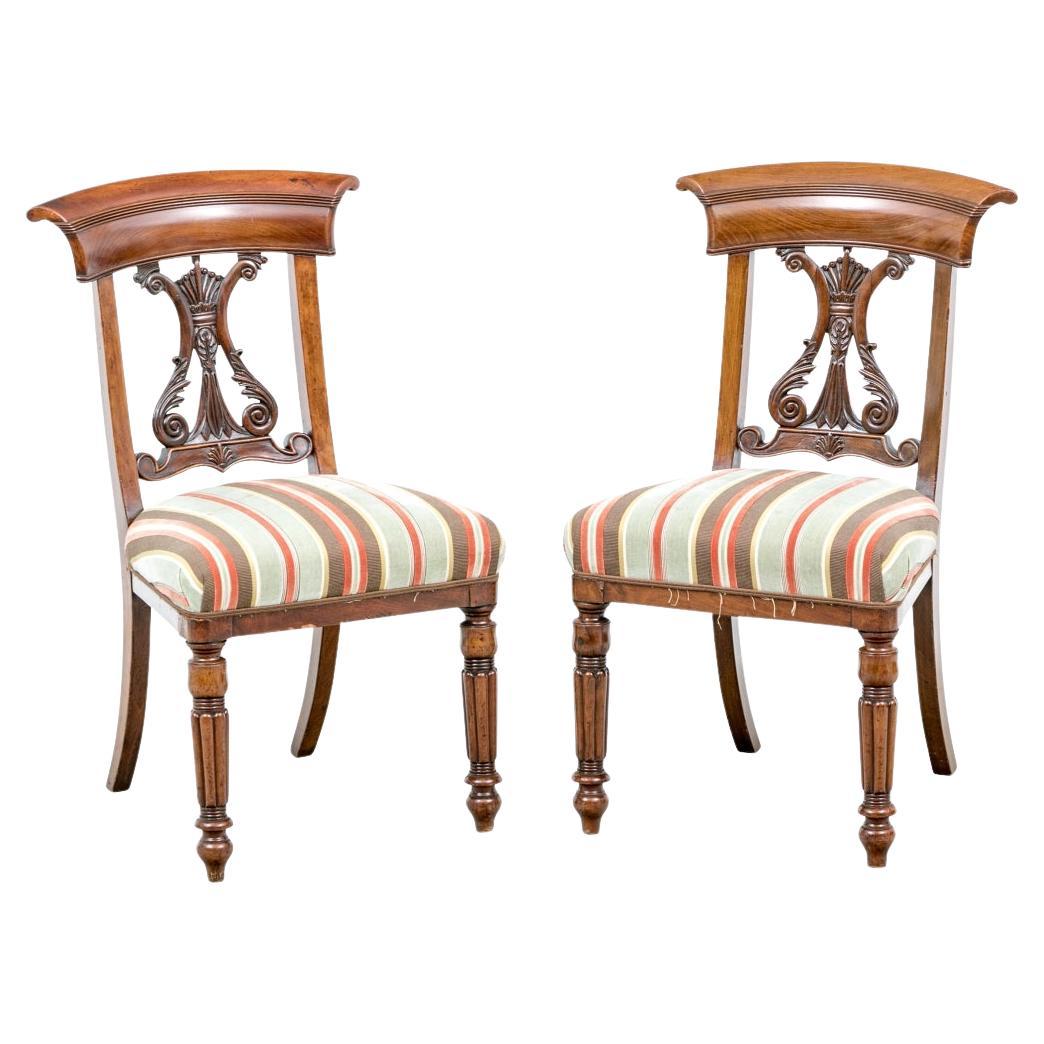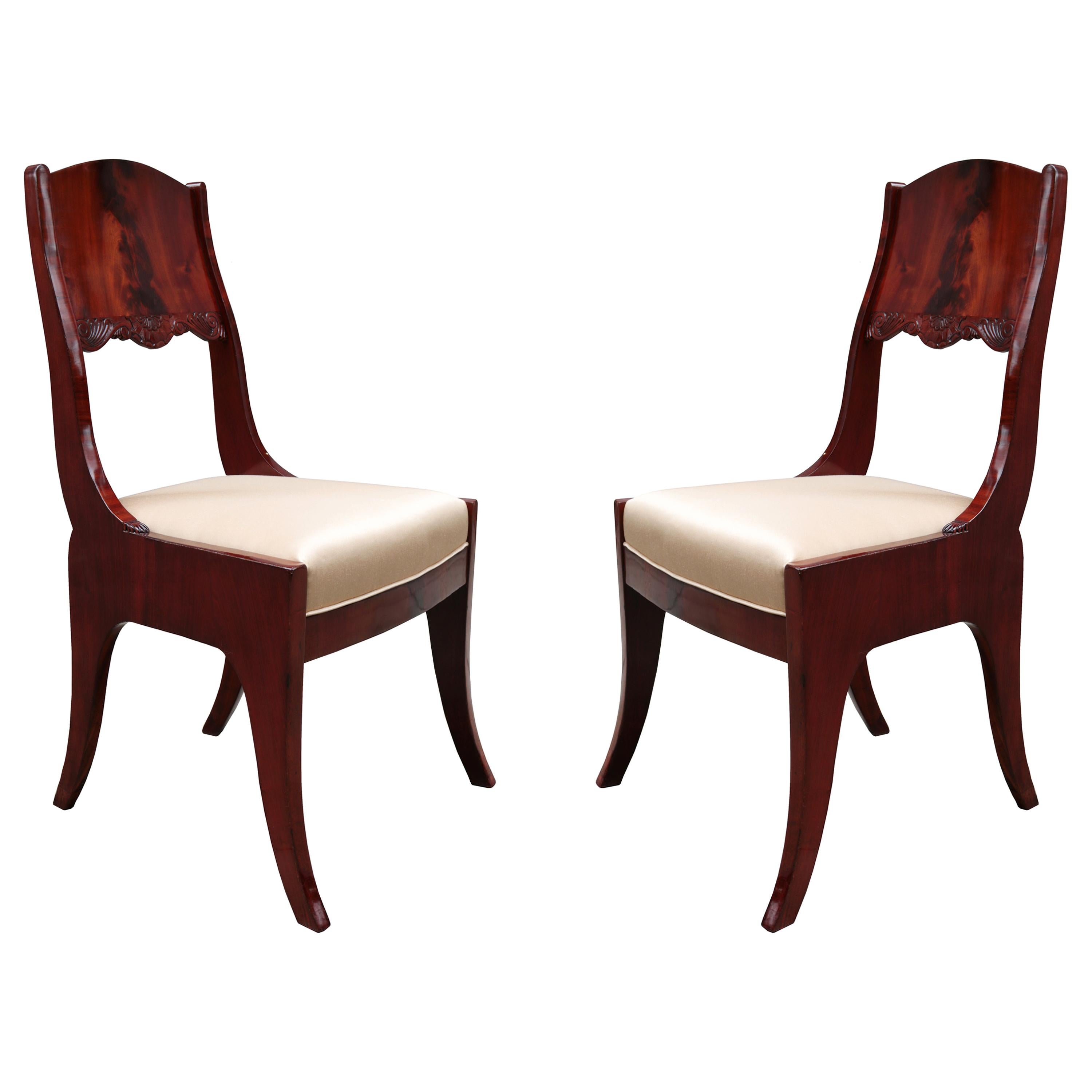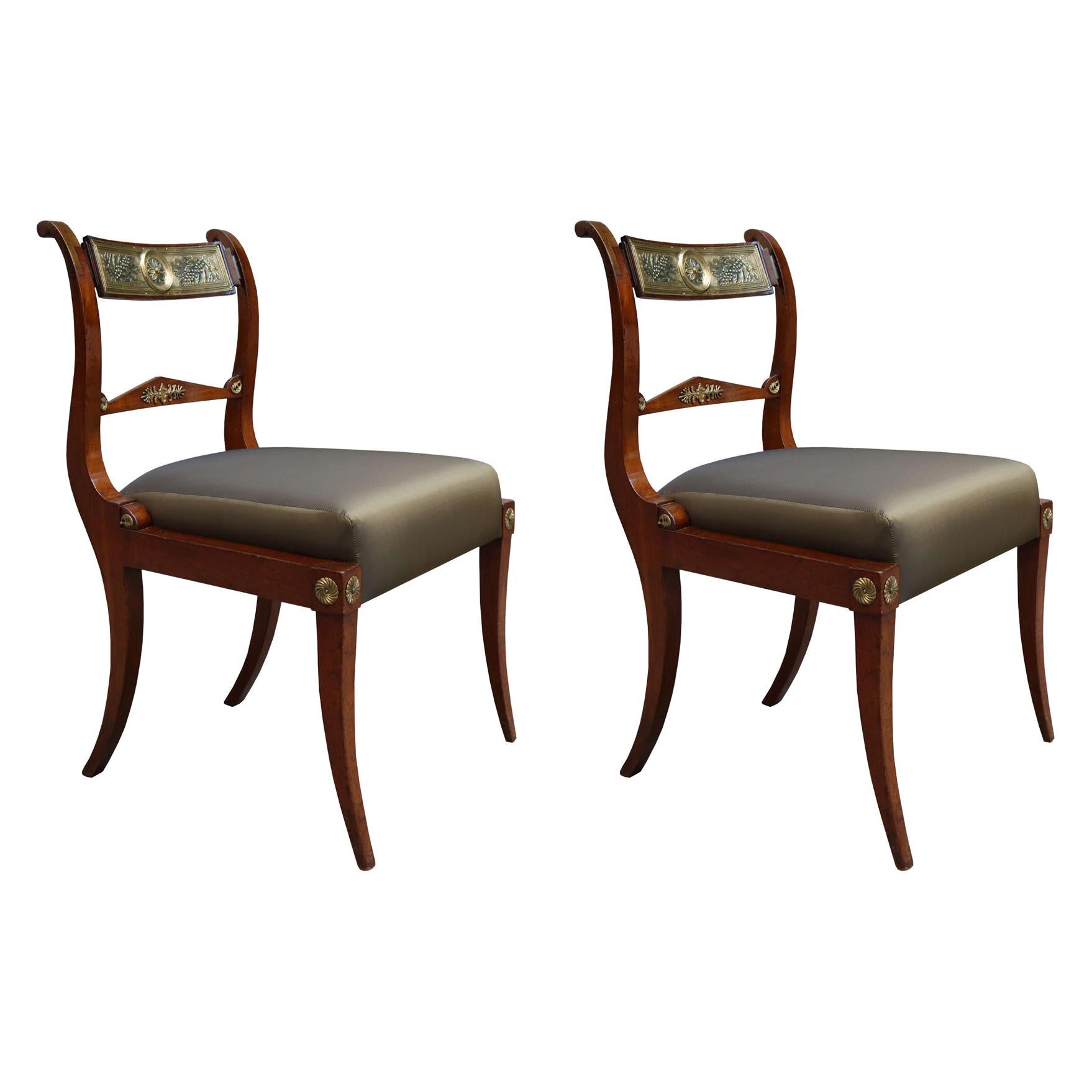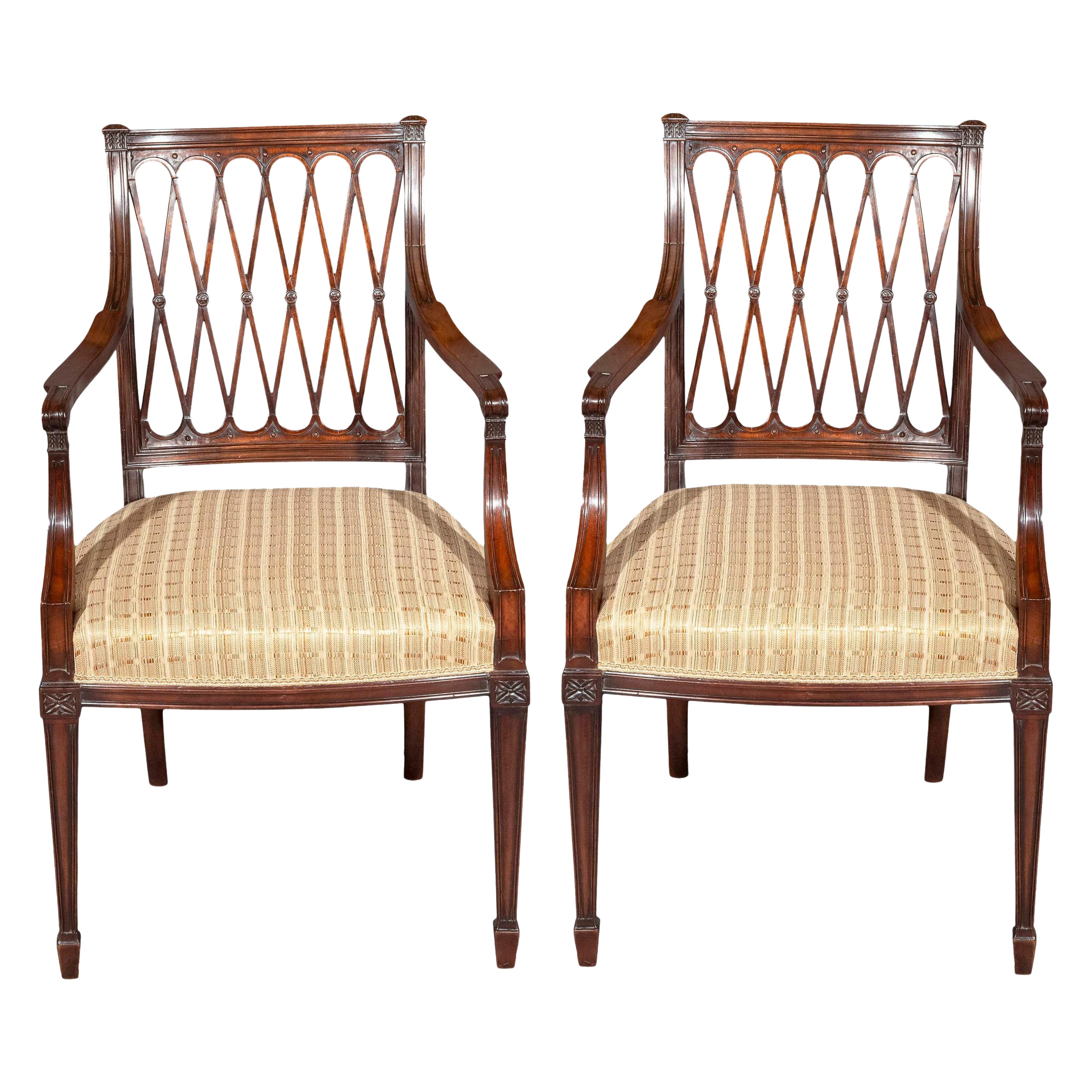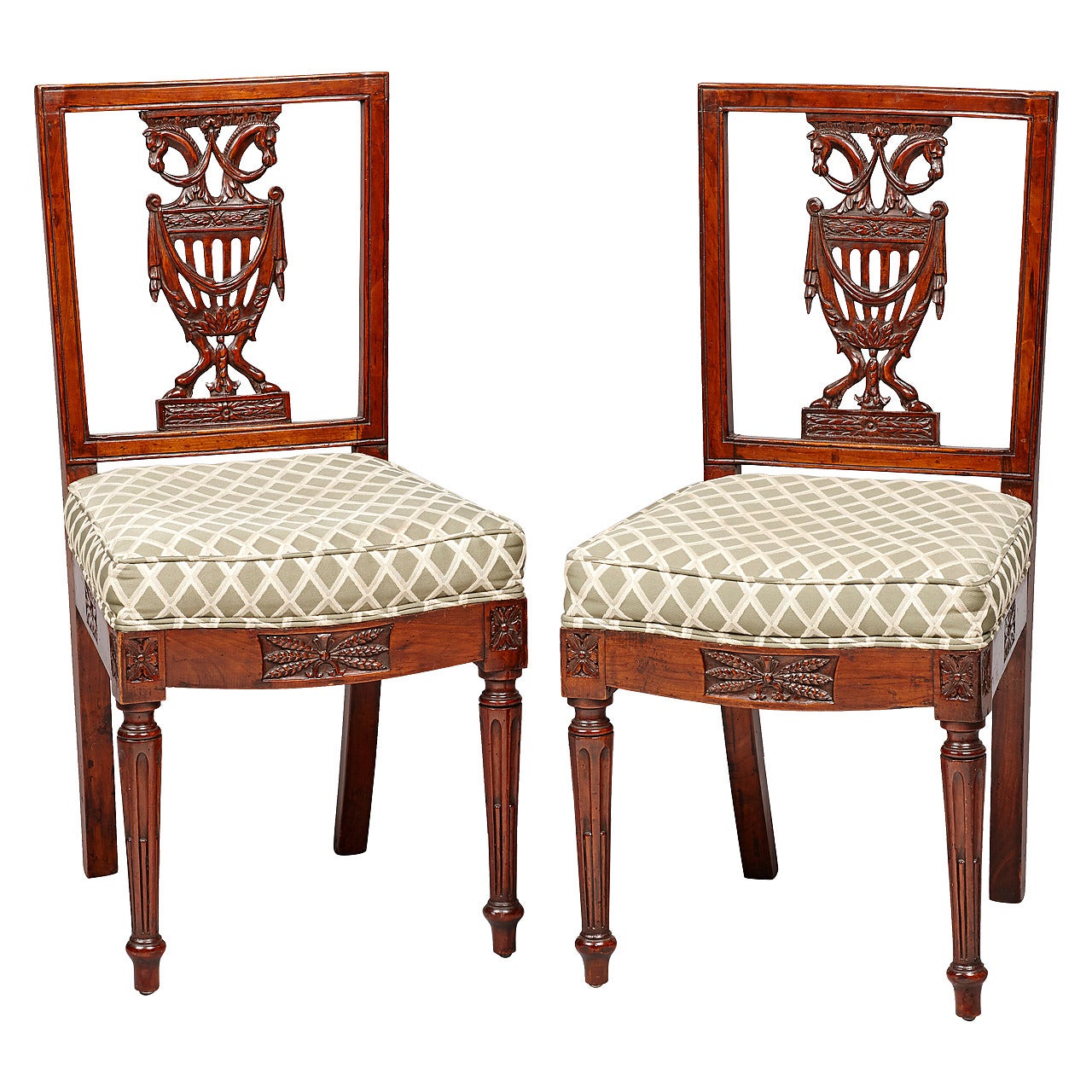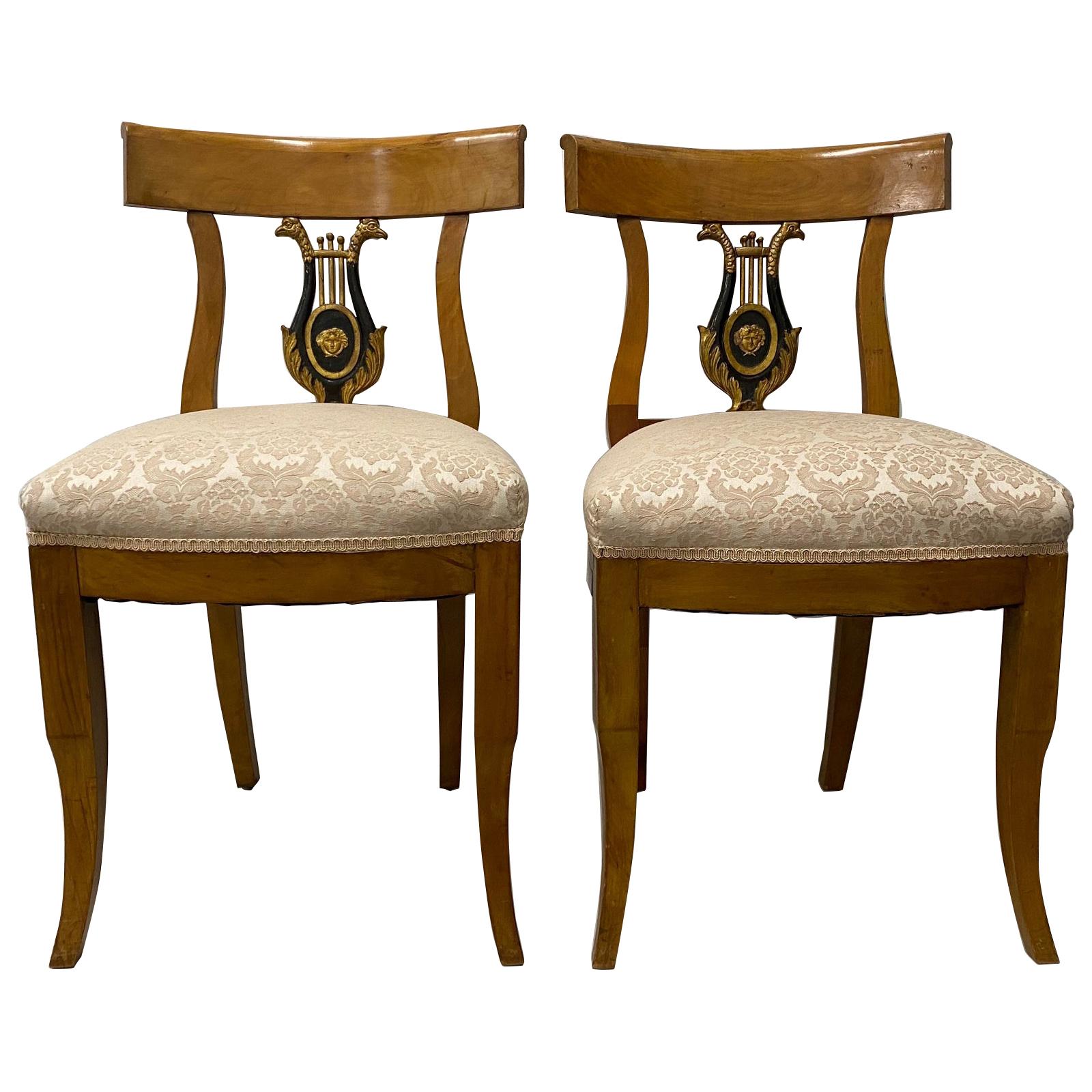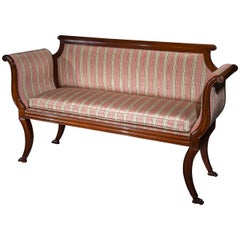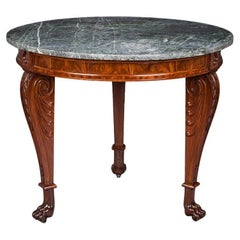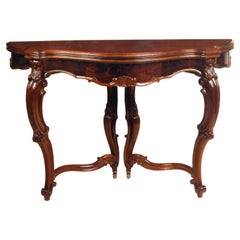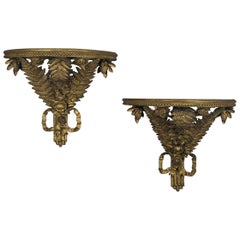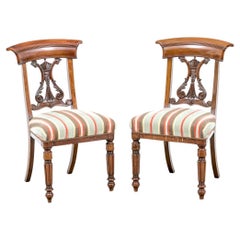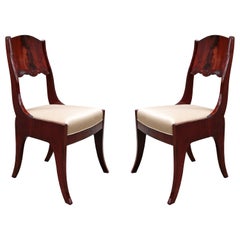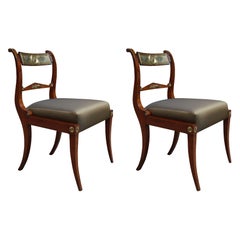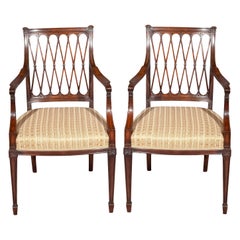Items Similar to Pair Side Chairs with Lyre Back
Want more images or videos?
Request additional images or videos from the seller
1 of 6
Pair Side Chairs with Lyre Back
$30,000per set
£22,654.80per set
€25,937.66per set
CA$42,367.84per set
A$46,255.54per set
CHF 24,249.89per set
MX$561,791.37per set
NOK 302,841.62per set
SEK 285,963.24per set
DKK 193,597.02per set
About the Item
“I know of no other chair like the single [sic] ‘lyre back’ one. . . . I certainly recognize it as a Boston chair considering all the individual elements, but the combination is particularly elegant.” So wrote noted scholar of Boston furniture Page Talbott when a set of four chairs of this design originally surfaced in the 1980s. Although the existence of four chairs in a specific pattern might imply that the chairs were originally part of a larger set, no additional chairs of this form have appeared in the intervening years.
The lyre became a popular motif during the Neo-Classical period, and is frequently encountered as the back splat of klismos chairs, in no example more familiar than in a group of Duncan Phyfe chairs (for example, see Berry B. Tracy et al., 19th-Century America: Furniture and Other Decorative Arts, exhib. cat. [New York: The Metropolitan Museum of Art, 1970], no. 27 illus.). In the present example, however, the cabinetmaker has created a substantially larger and bolder lyre—and a noticeably larger chair—more in keeping with the grander and more archaeological approach of the mid-to-late 1820s, in contrast to the more delicate Phyfe sensitivity of the 1810s. Indeed, these chairs represent both a scale and a level of refinement that one rarely encounters in Boston chairs of this time, except for a remarkable and monumental pair taken from Thomas King’s Modern Style of Cabinet Work Exemplified (1829), in the collection of the Detroit Institute of Arts, Michigan (formerly collection of Hirschl & Adler, FAPG 19411D; photograph in Hirschl & Adler archives).
The grander scale of these chairs, coupled also with the beautifully carved front legs and front and side seat rails boldly carved in an egg-and-dart motif, suggests that their cabinetmaker was looking to one of the many English design books that appeared during the Regency/William IV era, but the discovery in the private collection of the late Savannah, Georgia, dealer, Francis McNairy, of a set of six French side chairs with nearly identical lyre backsplats, and the appearance of a pair of side chairs with variant front legs and slight differences in the details of the lyre (catalogue, sale, Neal Auction Co., New Orleans, Louisiana, September 11-12, 2010, no. 365 illus.) strongly suggest that the origin of the design may have been in a French rather than an English pattern book of the period.
Overscaled lyres, albeit in a rather different form, are also seen in a series of three Boston work tables attributed to Thomas Seymour (see Robert D. Mussey, Jr., The Furniture Masterworks of John & Thomas Seymour [Salem, Mass.: Peabody Essex Museum, 2003], pp. 318 illus. in color, 319, as well as Albert Sack, The New Fine Points of Furniture: Early American [New York: Crown Publishers, 1993], p. 310 illus.), and also in various card tables, including a pair (Mussey, pp. 362 illus., 363) and a single (formerly in the collection of Hirschl & Adler Galleries, FAPG 14501D; see photograph in Hirschl & Adler archives).
- Dimensions:Height: 34 in (86.36 cm)Width: 19 in (48.26 cm)Depth: 22.25 in (56.52 cm)
- Sold As:Set of 2
- Style:Neoclassical (Of the Period)
- Materials and Techniques:
- Place of Origin:
- Period:
- Date of Manufacture:c. 1820
- Condition:Replacements made: One chair has had one glue block replaced and the other chair has had two glue blocks replaced. Repaired: There has been a veneer repair to the top of the back leg on the proper left side of one chair. The other chair has had a small veneer repair beneath the lyre. Reupholstered. Excellent overall. Cleaned and French polished.
- Seller Location:New York, NY
- Reference Number:Seller: FAPG 20849D.001-21stDibs: LU903241718422
About the Seller
No Reviews Yet
Recognized Seller
These prestigious sellers are industry leaders and represent the highest echelon for item quality and design.
Established in 1952
1stDibs seller since 2010
Associations
Art Dealers Association of America
- ShippingRetrieving quote...Shipping from: New York, NY
- Return Policy
Authenticity Guarantee
In the unlikely event there’s an issue with an item’s authenticity, contact us within 1 year for a full refund. DetailsMoney-Back Guarantee
If your item is not as described, is damaged in transit, or does not arrive, contact us within 7 days for a full refund. Details24-Hour Cancellation
You have a 24-hour grace period in which to reconsider your purchase, with no questions asked.Vetted Professional Sellers
Our world-class sellers must adhere to strict standards for service and quality, maintaining the integrity of our listings.Price-Match Guarantee
If you find that a seller listed the same item for a lower price elsewhere, we’ll match it.Trusted Global Delivery
Our best-in-class carrier network provides specialized shipping options worldwide, including custom delivery.More From This Seller
View AllSmall Settee in the Neoclassical Taste
Located in New York, NY
Small Settee in the neoclassical taste
Boston, Massachusetts (active 1804–17), about 1810
Mahogany (secondary woods: ash)
Measures: 35 1/8 in. high, 59 3/4 in. long, 19 1/8 in. deep
Although the diminutive scale of this settee places it in a unique category, the piece itself partakes of a vocabulary that is common in Boston furniture of the Late Federal period. Its sabre legs, for example, as seen straight on from the left and right ends, are closely related to the legs, as seen from the front, on a group of chairs of undisputed Boston origin, including a spectacular armchair with scrolled arms (see Stuart P. Feld, Boston in the Age of Neo-Classicism, 1810–1840, exhib. cat. [New York: Hirschl & Adler Galleries, 1999], p. 37 no. 6 illus. in color), as well as a number of side chairs, including a set made for Nathan Appleton (see Page Talbott, “Boston Empire Furniture, Part I,” The Magazine Antiques, CVII [May 1975], p. 887 fig. 12). In all, the legs are ornamented with two bold, somewhat flattened reeds set between corner beads, a pattern which is repeated here on the front and end seat rails as well. The superb quality of the piece is further demonstrated in the finely drawn profile of the arms, as well as the delicately bulbous surface of the fronts of the arms and legs. As in the best of the related chairs, the sabre legs end in delicately carved paw feet. The added refinement of the beautifully carved rosettes at both the fronts and backs of the arms suggests that the piece may have been designed to be used in the round.
Stylistically harmonious with these pieces is also a group of larger sofas with frontally set sabre legs and scrolled arms (see Page Talbott, “Seating Furniture in Boston, 1810–1835,” The Magazine Antiques, CXXXIX [May 1991], p. 963 pl. 11) that represent an indigenously Boston form. Although none of the furniture in this group has been effectively attributed, they can certainly be related to various Boston card tables...
Category
Antique Early 19th Century American Neoclassical Settees
Materials
Wood
Center Table with Scroll Legs, Paw Feet and Marble Tops
By Thomas Seymour
Located in New York, NY
Center Table, about 1818–20
Attributed to Thomas Seymour (1771–1848), working either for James Barker or for Isaac Vose & Son, with Thomas Wightman (1759...
Category
Antique 1810s American American Classical Center Tables
Materials
Wood, Mahogany
Card Table in the Rococo Taste
By Charles A. Baudoine
Located in New York, NY
RECORDED: cf. Anna Tobin D’Ambrosio, ed., Masterpieces of American Furniture from the Munson-Williams-Proctor Institute (Syracuse University Press, Utica, New York, 1999), pp. 85, 86, 87 illus. the Munson-Williams-Proctor tables // cf. The Metropolitan Museum of Art, New York, 19th Century America–Furniture and Other Decorative Arts (1970), exhib. cat., [n.p.] no.133
This table is identical to a pair of card tables bearing the stenciled label of Charles A. Baudouine of 335 Broadway, New York, which were acquired by James and Helen Munson Williams of Utica, New York, in May 1852 for their home, Fountain Elms, which is where they remain today as part of the Munson-Williams-Proctor Art Institute collection. The Williams tables were billed as “1 Rosewood Multiform Table” at $160 for the pair, and they were indeed “multiform” in that they could be used separately and folded as a pair of console tables, opened as a pair of card tables, or joined together as a center table. The present table varies essentially in the fact that it does not include the mechanism that would have allowed it to be attached to another to form a center table.
Of French descent, Baudouine was born in New York in 1808. He made his debut as a cabinetmaker in the New York directory of 1829/30, where he is listed at 508 Pearl Street. By 1839/40 he relocated to Broadway, where he remained in business at various addresses until about 1854. A sense of the scale of Baudouine’s operation is given by German immigrant cabinetmaker Ernest Hagen...
Category
Antique Mid-19th Century North American Rococo Revival Card Tables and T...
Materials
Wood, Rosewood
Pair of Fern Wall Brackets
Located in New York, NY
American, circa 1850-1880.
Eastern white pine (Pinus strobus), with wire armature and composition ornament, gessoed
and gilded.
Measures: 14 1/8 in. high, 16 5/16 in. wide (at the sh...
Category
Antique 19th Century American Aesthetic Movement Wall Brackets
Materials
Wood
$55,000 / set
Pier Table
Located in New York, NY
One of the signature forms of the Neo-Classical period, the pier (or console) table received its name from its typical use against the wall, or pier, between two windows. Pier tables...
Category
Antique 1810s American Neoclassical Tables
Materials
Marble, Brass, Bronze, Lead
$65,000
Pier Mirror in the Neoclassical Taste
Located in New York, NY
New York, circa 1815-1820.
Wood, gessoed and gilded, with mirror plate.
75 1/2 in. high, 44 1/8 in. wide (at the cornice), 8 1/2 in. deep (at the cornice).
Condition: Some restorati...
Category
Antique 19th Century American Neoclassical Pier Mirrors and Console Mirrors
Materials
Mirror, Wood
You May Also Like
Pair Of Fine Neoclassical Style Lyre Back Side Chairs
Located in Bridgeport, CT
Possibly Italian. Elegant side chairs with curved and scrolled crest rails with reeded bands. The lyre form splats with finely carved scrolled leafy sides and a center palmette and l...
Category
Antique 19th Century European Neoclassical Side Chairs
Materials
Fabric, Wood
Pair of Neoclassical Side Chairs
Located in New York, NY
Pair of neoclassical side chairs.
Mahogany with carved details.
Category
Antique 1820s Russian Neoclassical Side Chairs
Materials
Mahogany
$9,800 / set
Fine Pair of Neoclassical Side Chairs, 1st Half 19th Century
Located in New York, NY
An elegant pair of Italian Neoclassical mahogany chairs adorned with patinated brass mounts from Italy. These chairs feature bold saber shaped legs and vertical lyre shaped back supp...
Category
Antique Early 19th Century Italian Neoclassical Side Chairs
Materials
Brass
Pair of 19th Century Open Armchairs
By Gillows of Lancaster & London
Located in Richmond, London
A superb quality pair of open armchairs, after late 18th century designs by Gillows of Lancaster and London, the manufacture attributable to Gillow & Co. English, circa 1880.
Why we like them
Wonderfully elegant model, looking very delicate but in fact unusually strong – the sign of a skilled craftsman. Interestingly, chairs of this exact model can be seen in a painting by Walter Dendy Sadler (British, 1854-1923), The After Lunch Conversation, 1889, sold at Doyle, New York, 21 May 2024, lot 83.
Design
These chairs correspond to Gillows’ 'Garforth pattern' - a rare and highly desirable design - which first appeared in 1795 and was probably an adaptation of Georges Jacob's design of circa 1792 for Marie-Antoinette's dairy at Rambouillet. Gillows made the chairs not only in mahogany but also japanned, and they appear to have been particularly popular among the genteel, professional, and merchant classes in the north of England. In 1796, the Earl of Strafford purchased six white and green japanned chairs for Wentworth Woodhouse...
Category
Antique Late 19th Century European Armchairs
Materials
Upholstery
$5,469 / set
Pair of Royal Late 18th Century Neoclassical Berlin Side Chairs
Located in Worpswede / Bremen, DE
The finely carved unusual splat with two horse heads in the centre holding draperies in their mouth above a classcial pierced splat decorated with further draperies and supported by ...
Category
Antique Late 18th Century German Neoclassical Side Chairs
Materials
Wood
Pair of 19th Century Empire Lyre Back Dining Chairs
Located in San Francisco, CA
Pair of 19th century Empire Lyre back dining chairs
Wonderful pair of walnut dining chairs with carved double eagle head and lyre carving.
Mea...
Category
Antique Late 19th Century Austrian Empire Side Chairs
Materials
Walnut
More Ways To Browse
Robert Thomas
Duncan Phyfe
Pair Of Georgian Side Tables
Card Table Pair
Splat Back Chairs
Antique Duncan Phyfe
William IV Mahogany Work Tables
Antique Duncan Phyfe Chair
Antique Mahogany Lyre Back Chairs
B Berry
Duncan Phyfe Table And Chairs
Gold Gilt Chairs Faux Bamboo
H Dining Chair Estudio Persona
Hague Chairs
Hans Wegner 525
Hans Wegner Butterfly Chair
Hans Wegner Valet Chair
Hex Chair
